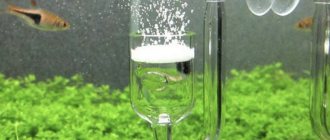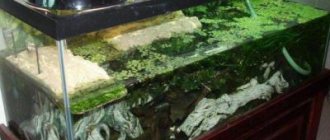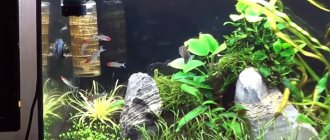Home \ Services \ Aquarium repair
There are often cases when underwater hobbyists and professionals may need to repair their aquarium or components. There are many reasons for this: from the consequences of careless use to low-quality equipment.
At the same time, it is important to react to the problem in time and quickly solve it, otherwise not only the expensive structure, but also the lives of its inhabitants will be at risk. The OASIS company is ready to offer you urgent repair services for home or commercial tanks at an affordable cost for all types of equipment.
Repair of aquarium lamps in Moscow
Depending on the time of use and quality, sooner or later the old lamp will let you know about the need for repairs and replacement of parts. The specialists of the OASIS company are ready to help you troubleshoot the device in a timely manner or give recommendations for replacement.
The service includes:
- Lamp diagnostics;
- Replacement of wiring, ballast, etc.;
- Collection and sealing of the device;
- Testing the lamp for damage and tightness.
Our specialists will help you install the repaired lamp in place and connect it in your presence.
Where should I put the fish?
Decorative fish and other living creatures must be evacuated immediately. If there is a spare housing for aquatic inhabitants (even if of a smaller capacity), then the problem is solved quite simply: water from the faulty aquarium is poured into a spare one, the plants are moved to a separate container (a jar, for example), and the soil is removed.
You can start troubleshooting. If you have a thermal bag for transporting fish, then it will also be suitable as a temporary home for fish. As a last resort, you can use an ordinary three-liter glass jar.
Requirement: the same conditions must be maintained in the temporary container (the aqua must be saturated with oxygen, and its temperature must be maintained within normal limits).
Any aquarium can be repaired - it has been tested by experience, and repeatedly! The complexity and type of aquarium repair is determined by the nature of the destruction.
First way. The easiest way is to glue a new bottom over the cracked one. And when gluing, apply a continuous strip of aquarium sealant to the place of the crack to prevent leakage. Along the perimeter of the aquarium, flush with the new bottom, it is necessary to stick a strip of glass 4-5 cm wide (glass thickness 4-5 mm) - this serves as reinforcement and provides an additional guarantee against leakage. Subsequently, the strip can be decorated by gluing a self-adhesive film or decorative tape onto it, and it will not attract attention at all or look like something alien, rather as if it was intended that way.
Note:
Pet stores or household chemical stores sell special silicone sealant for gluing and repairing aquariums. Be careful when purchasing it; it should be written on the packaging that it can be used for aquariums. You can glue it without draining the water; it is harmless to the inhabitants of the aquarium. To seal, you need to bring the sealant to the crack, dispense it and smear it with your fingers in the crack.
Once the sealant has cured (usually 24 hours), you can carefully remove the excess using a razor blade. It is necessary to monitor the area where the crack was for several days, as water may begin to seep through. In this case, it is necessary to repeat the procedure.
Method two. Place a glass patch in place of the crack, which will cover the entire damaged area. If the aquarium leaks along the seam, you will have to re-glue this entire seam. To do this, you will need to remove the old silicone from the entire seam, since the silicone of the new gluing does not stick well to the old silicone. Then let the aquarium sit for 4-6 days. Next, soak for a week (drain the water twice a day and refill the aquarium again) and you can again place your fish in their usual environment.
Note! If any of the walls of the aquarium are damaged, the entire damaged glass must be replaced.
The third, more complex option is replacing the bottom - a long process in technical terms, because it may require disassembling half of the aquarium.
THE BEST CORAL REEFS IN THE WORLD
HOW TO CHOOSE AN AQUARIUM FOR YOUR HOME: DESCRIPTION, PHOTO
AQUARIUM - DIVISION OF AQUARIUMS BY PURPOSE
BEST AQUARIUM SIZE FOR BEGINNERS - SMALL OR LARGE AQUARIUM?
Aquarium repair in Moscow: eliminating leaks
A leaking tank body is one of the most common reasons for calling service among aquarium hobbyists. The reasons for this problem lie in the natural wear and tear of the sealant, which loses its properties over time.
OASIS service technicians are ready to identify the source of the leak and eliminate it by applying an additional layer of sealant. In this way, you can protect the aquarium from subsequent difficulties due to loss of tightness and save an impressive portion of your budget.
Cracks
It happens that during the operation of the aquarium, cracks appear; again, it is necessary to strictly differentiate those cracks that appeared as a result of careless operation of the product or as a result of improper manufacture of the aquarium. In any case, it is necessary to replace the glass(es) if cracks are detected. Sometimes the crack is not through and does not allow a leak, aquarists make the wrong decision about the further operation of the aquarium. But this is the most wrong decision. The aquarium can no longer be used. The fact is that despite all its solidity, the aquarium is not a rigid structure. Thanks to the adhesive seams, the glass of the aquarium has the ability to “walk” within certain limits; if the aquarium were solidly cast, then the operation of even a 30-liter container would be very problematic, due to the distribution of loads on the glass. Therefore, if cracks occur and the cause is identified, it is necessary to immediately begin repairing such an aquarium.
Gluing an aquarium from the OASIS company
If, as a result of an impact, a dangerous crack or, even worse, a hole appears on the glass of an aquarium jar, an ambulance is needed: under such conditions, the inhabitants of the vessel and expensive equipment are in danger, which will then have to be replaced. To eliminate the threat, contact our service center, whose employees will offer:
- Urgent measures to ensure the safety of plants and animals;
- Draining the water and emptying the aquarium;
- Drying the jar;
- Selection of new glass for replacement;
- High-quality gluing of the tank.
After this, you can take advantage of the offer to restart the aquarium system.
Chips
During the operation of the aquarium, chips on the surface of the glass very often occur due to various reasons. Whether it is a shock or distortion of the aquarium during installation, transportation, etc. In any case, such glass must be replaced; the chip is not as deep as a crack, but still breaks the solidity of the structure and poses a danger to the further operation of the aquarium. When a chip appears on the surface of the glass, it is necessary to eliminate not only the consequences, but also to identify the reason why it occurred. The glass was damaged either due to a simple impact. Either the internal stress of the glasses became so high that the glue “pulled” the glass, or one glass deformed the other. Internal chips are much more dangerous than external ones.
Repair of aquarium filters and other replacement equipment
Malfunctions of the filtration system always cause countless problems for the underwater population, the most harmless of which are discomfort and illness. If you notice that the device has become worse or has stopped working altogether, use the aquarium equipment repair service.
Service center “OASIS” is ready to offer repairs:
- External and internal filters;
- Compressor;
- Thermostat;
- Chillerov;
- Ionizer, etc.
If the broken device cannot be repaired, we will offer the best options for replacement equipment, order them, deliver them and install them at an affordable price. You can also order turnkey marine and freshwater aquariums. Check out our services and ask any questions you have during a free consultation.
The best way to glue ceramics and porcelain
I would like to extend the life of ceramics. It is not only used for its intended purpose, but also decorates the interior with its originality and uniqueness. It’s hard to say which is better ceramics or porcelain in terms of quality and durability, it all depends on various factors.
How to glue porcelain and ceramics? Which glue for porcelain and ceramics should I choose? Or maybe throw away the broken product? Should I throw away the broken vase or not? If not, how to glue a ceramic vase?
Don't rush to throw it away. You can always throw it away. First you need to try to glue the product, and if nothing works, then you can throw it away. Throwing it away is the last thing left to do.
How to glue ceramics
Various adhesives are used to repair ceramics. There are a huge variety of products available on the market for repairing ceramic cookware.
Ceramic tableware
The following Russian-made adhesives for repairing ceramic tableware are offered for sale: “Second”, “Super-moment”, “Cyanopan”, “Glue”, “Sila”, “Monolith”, “Elephant”. There are also imported adhesives for gluing. The best waterproof glue for ceramics is MARS.
Waterproof glue
For ceramics that are used to store food, you can use PVA glue for gluing. But, it is recommended that after gluing the ceramic cup is covered with a layer of varnish. For gluing ceramic products, you can use epoxy glue, F-2 and BF-4 adhesives.
How to glue porcelain
The following range of adhesives for porcelain is offered for sale – STANGE, “cosmofen ca-12”, you can also use “RAPID”. Among Russian-made adhesives, carbinol glue should be noted. Also, instead of glue for repairing porcelain, you can use epoxy resin EPOXY GLUE produced by BONDO, BIZON or similar adhesives.
China
To glue porcelain, you can use cement made from gypsum. To do this, add the white of 1 egg to the gypsum powder and mix very well. The resulting glue can be used to glue porcelain. Moreover, the gluing procedure should be performed very quickly, because this glue hardens quickly.
For gluing, you can make other glue at home. To do this, mix 1 egg white and soda. Beat Belov into foam, without adding soda. The whipped white should sit for one day, and only then add soda to the settled white and mix. You should add enough soda to get a mass similar in consistency to regular dough.
Very often, food glue is recommended for repairing porcelain, which is easy to make at home.
To do this you should:
- Take 1 liter of water. Add 100 g to water. Sugar, 100 gr. lime (necessarily slaked). Place the resulting mixture on the fire and cook over low heat for about 3-3.5 hours. The main thing when “cooking” is that it does not boil.
- Cool the resulting broth and let it sit for a few more hours.
- The water that remains after settling must be drained.
- Add 0.5 kg to the mixture. tile adhesive. Mix well and leave to settle again for 10-15 hours.
- If there is excess water, it must be drained. Boil the resulting mass one more time.
- Cool. Porcelain glue is ready.
This adhesive for food utensils is ideal.
Universal adhesives for both materials
There are a huge number of universal adhesives. These are adhesives that can be used to glue both porcelain and ceramics - casein glue, epoxy adhesives. The most popular is Porcelan Potch glue. Edible glue is often suitable for gluing both ceramics and porcelain. For example, the recipe described above can be used as an adhesive for ceramics and porcelain.
Porzellan Potch glue
Defects associated with stiffeners
Modern methods of gluing aquariums sometimes include increasing the strength of the structure by gluing stiffeners in the top part of the aquarium. It must be said that some aquarium “masters” very often use stiffeners in order to reduce the thickness of the main glass, thereby reducing the cost of the aquarium, this is not true. The thickness of the glass in the aquarium should correspond to its volume and size. The required proportions and values can be found in special tables. With such violations, the following defects very often occur: - Complete or partial peeling off of the stiffener. — Chips at the joints of the stiffener or the main glass. — A broken stiffener due to the strong tension of the main glasses.
I would also like to highlight such points as poor quality glass and poor quality glue.
For the manufacture of aquariums, glass of the M0 grade is used, which should not contain any bubbles, streaks or other external defects. Very often, manufacturers save money and use poorer quality glass for front and bottom glass. Which are not so noticeable, thereby reducing the cost of the structure, while making it less durable. Regarding silicones. For the production of aquariums, aquarium silicone is used that is extremely durable and has increased adhesive properties. Silicone has its own shelf life, as well as temperature and time operating conditions.
If the above parameters are violated, the strength of the seams is significantly reduced. Very often, in order to save money, manufacturers save on silicone by using low-quality silicone, or even using glass mastics, which is fundamentally unacceptable.










